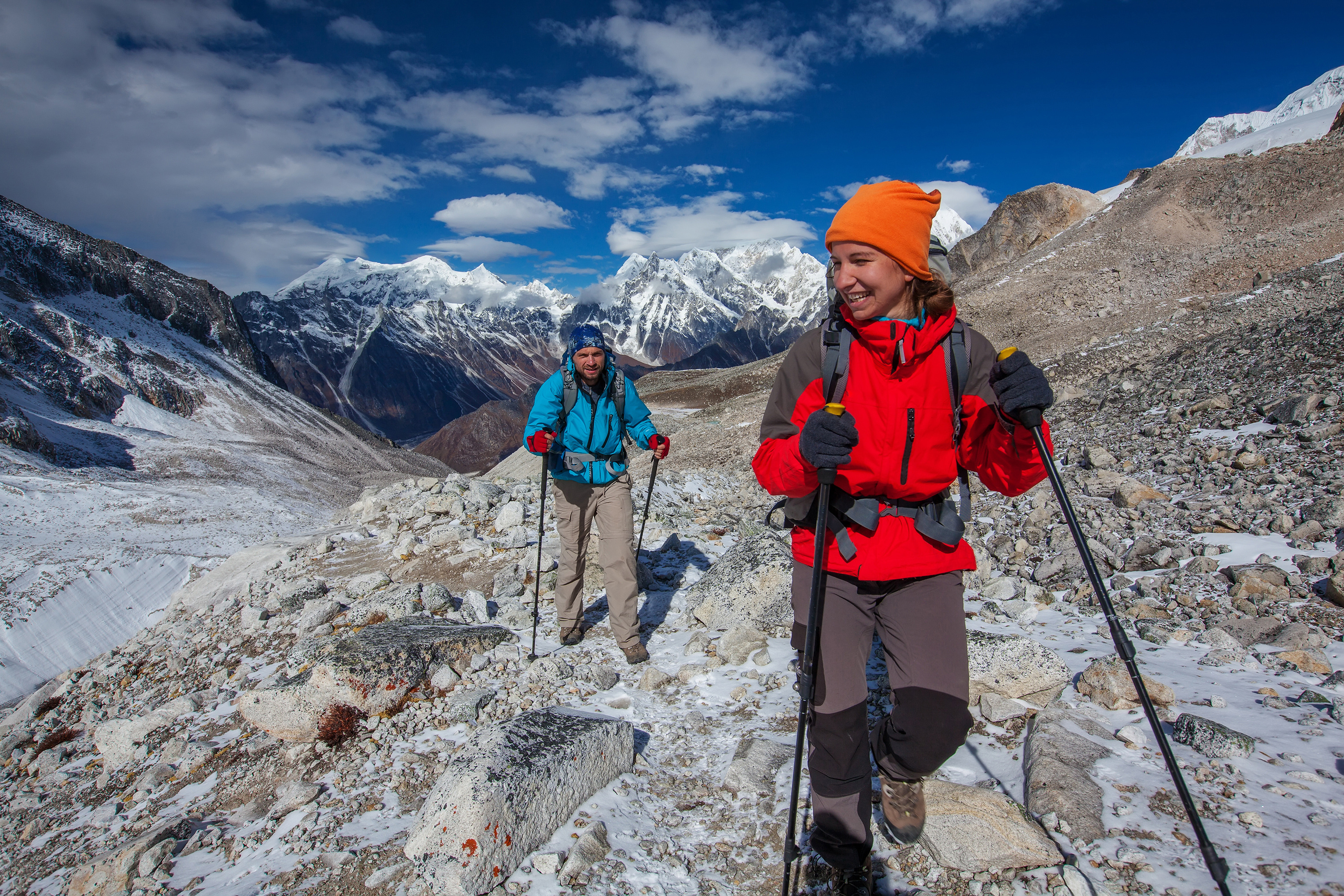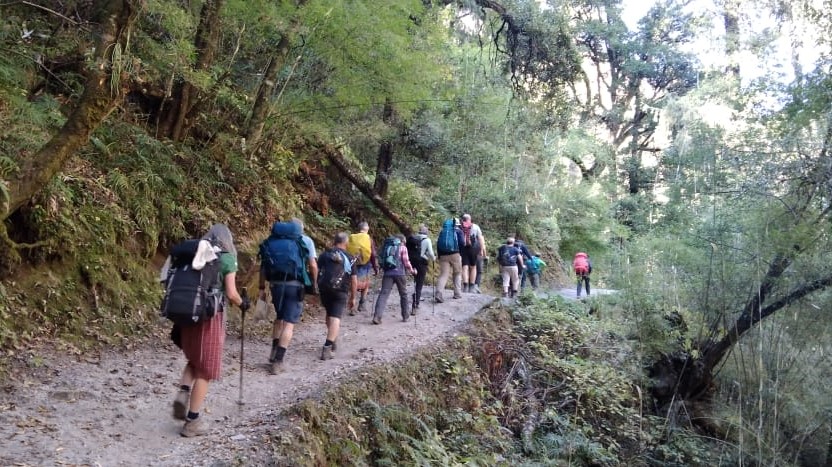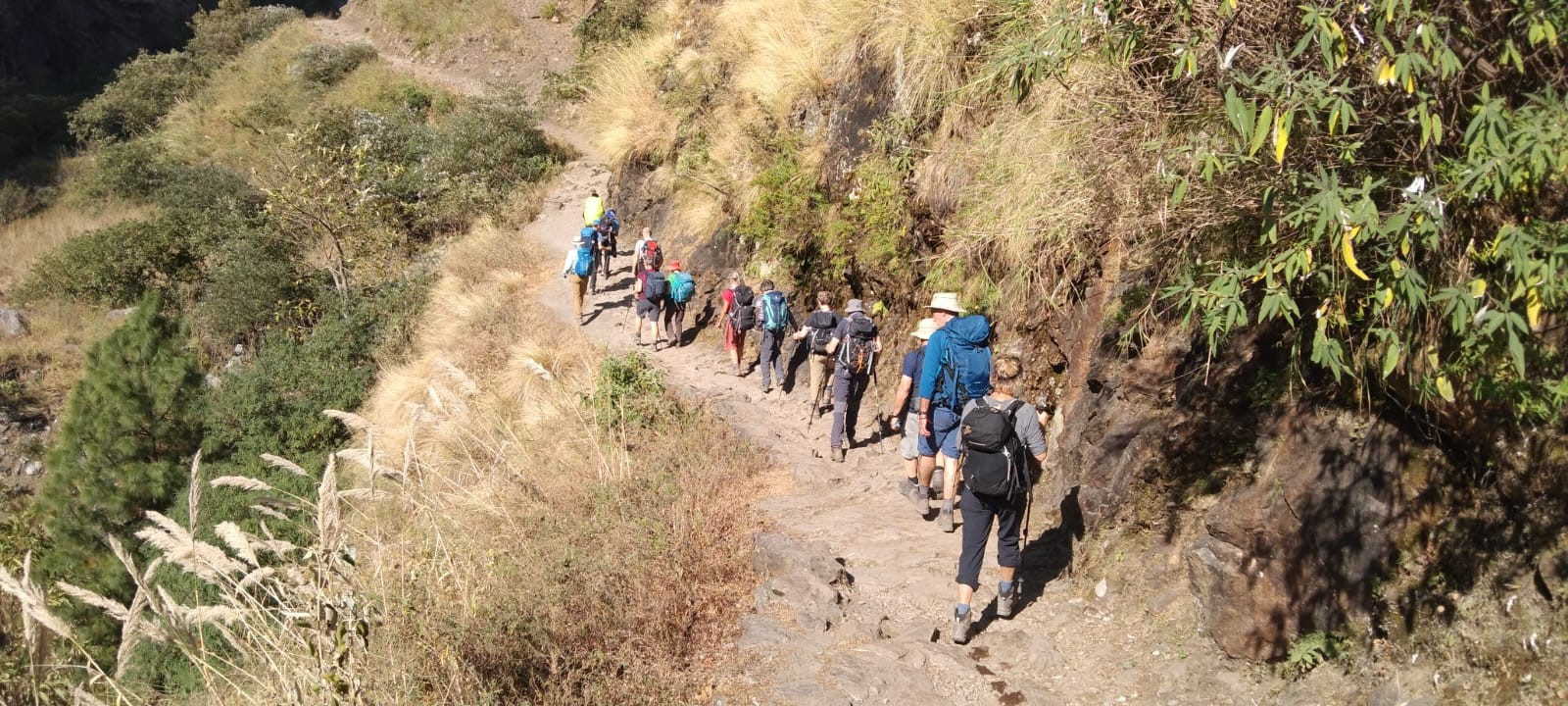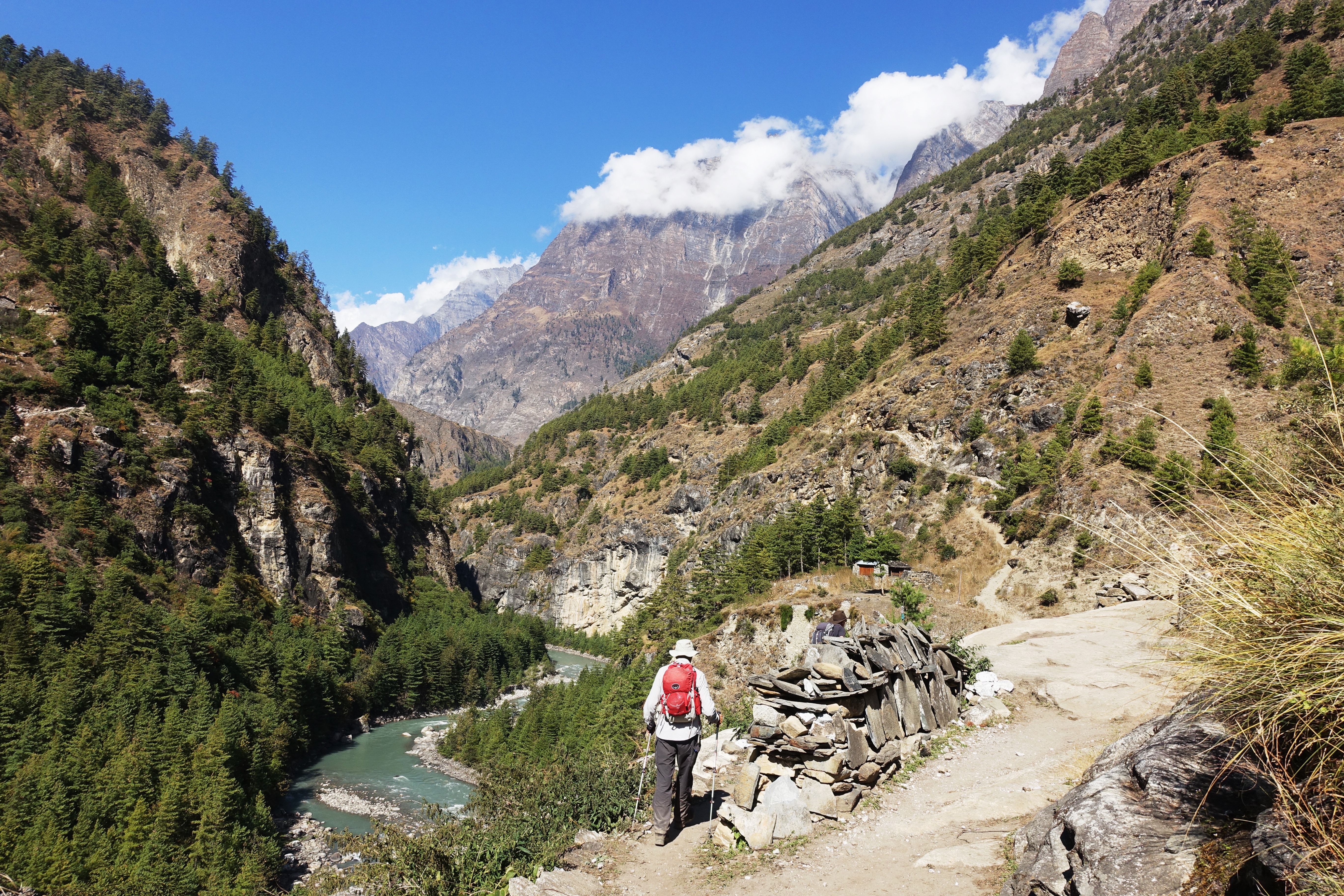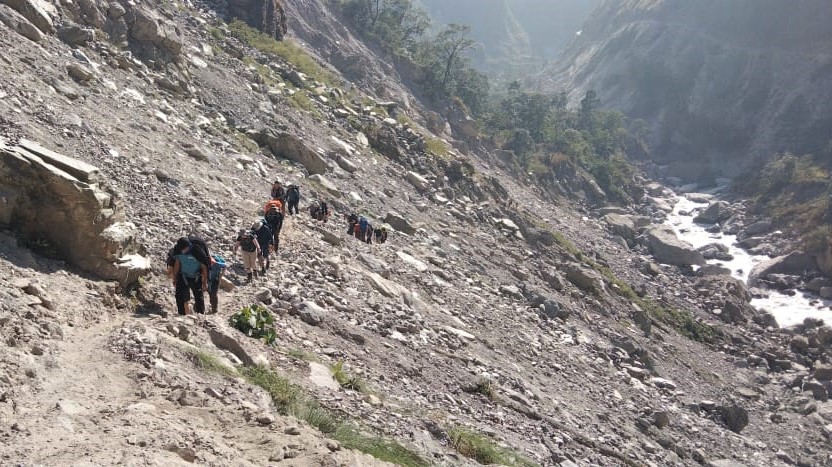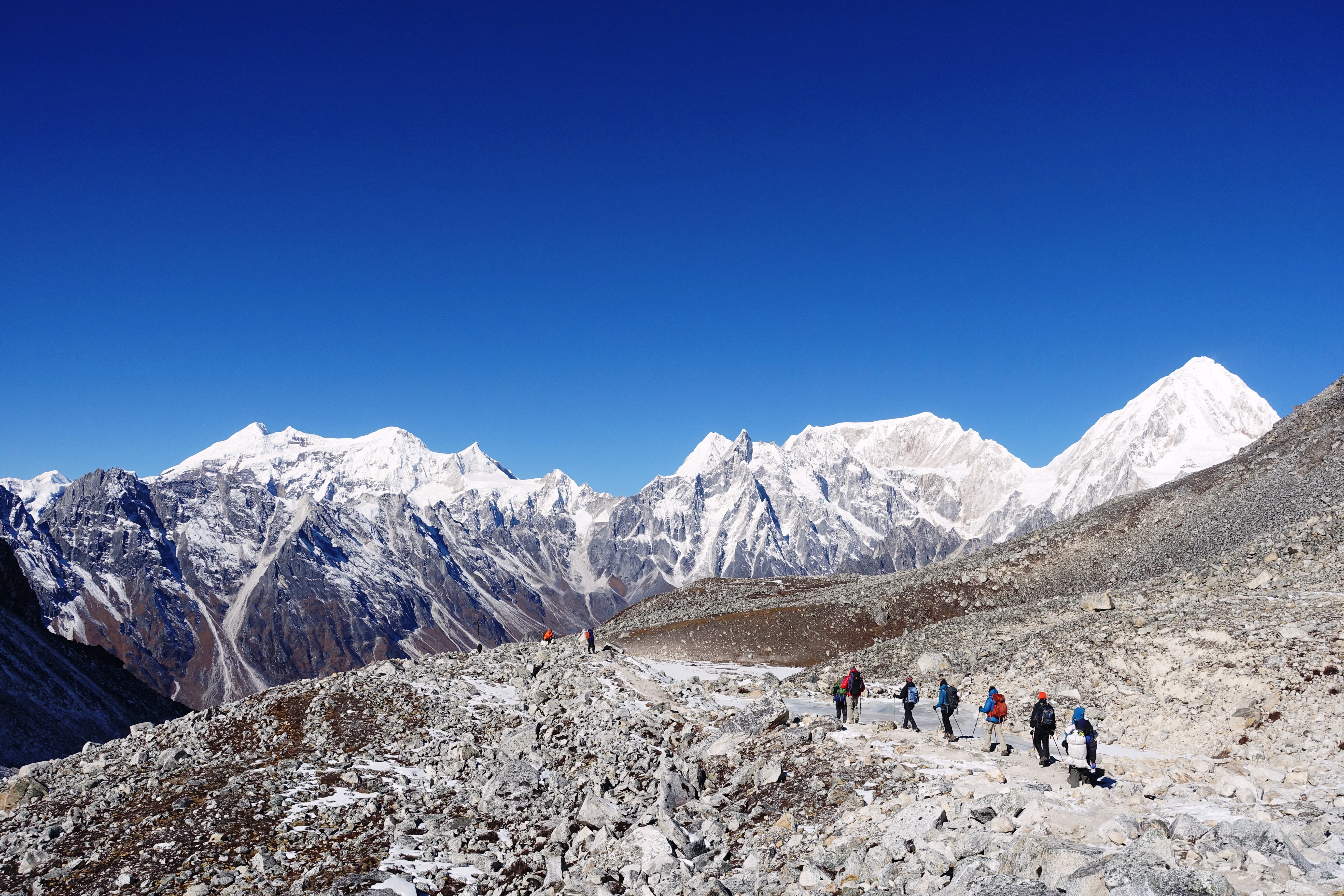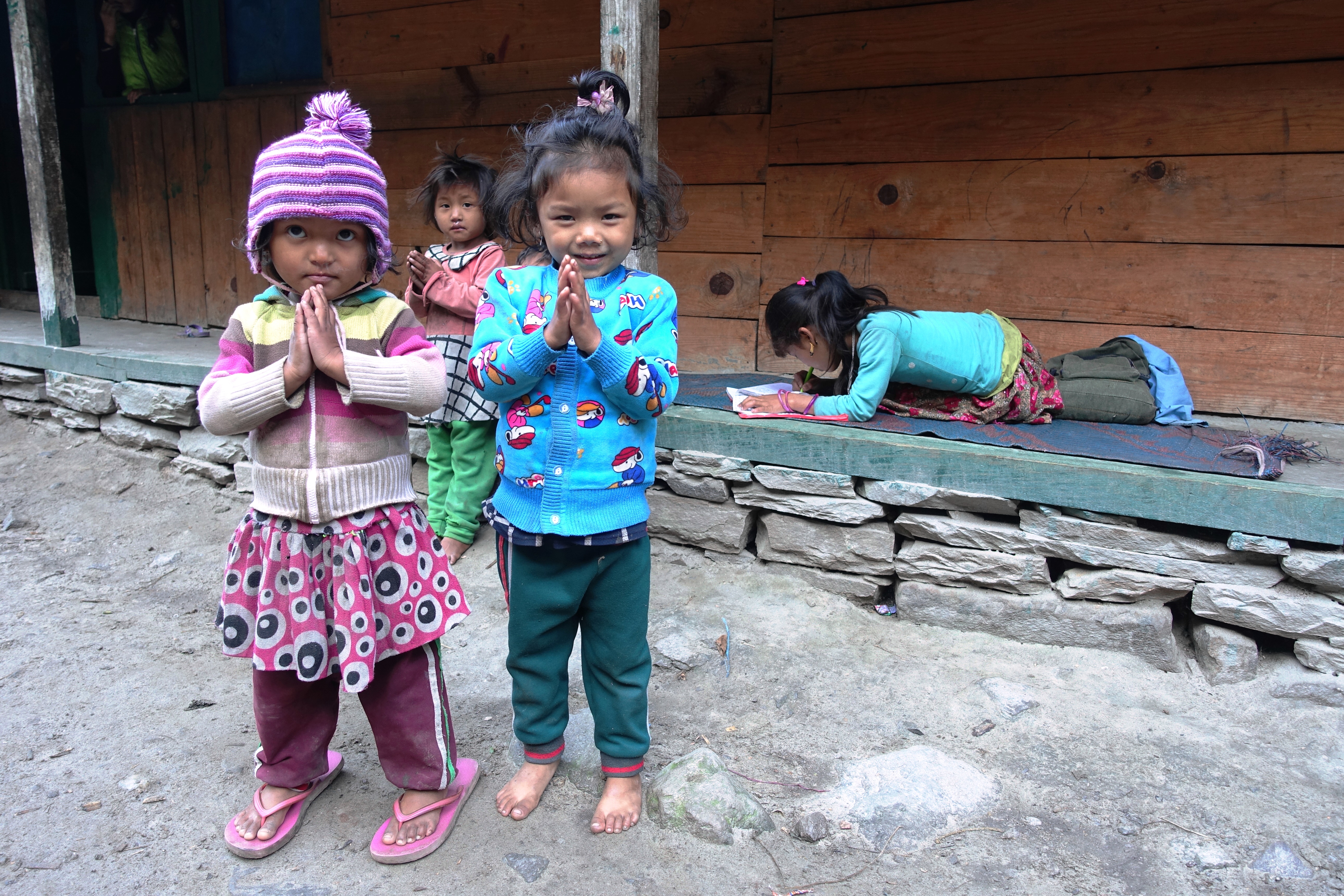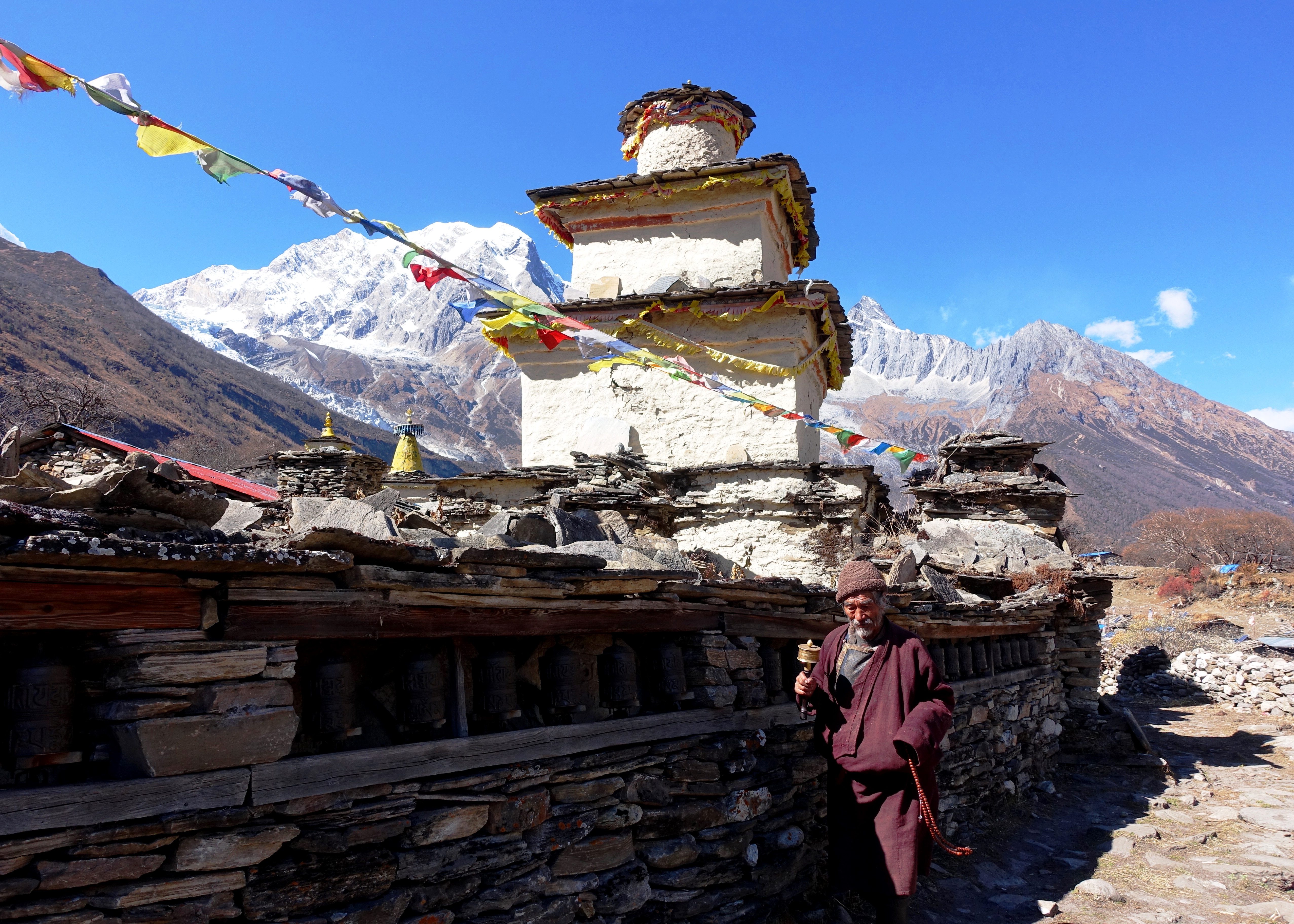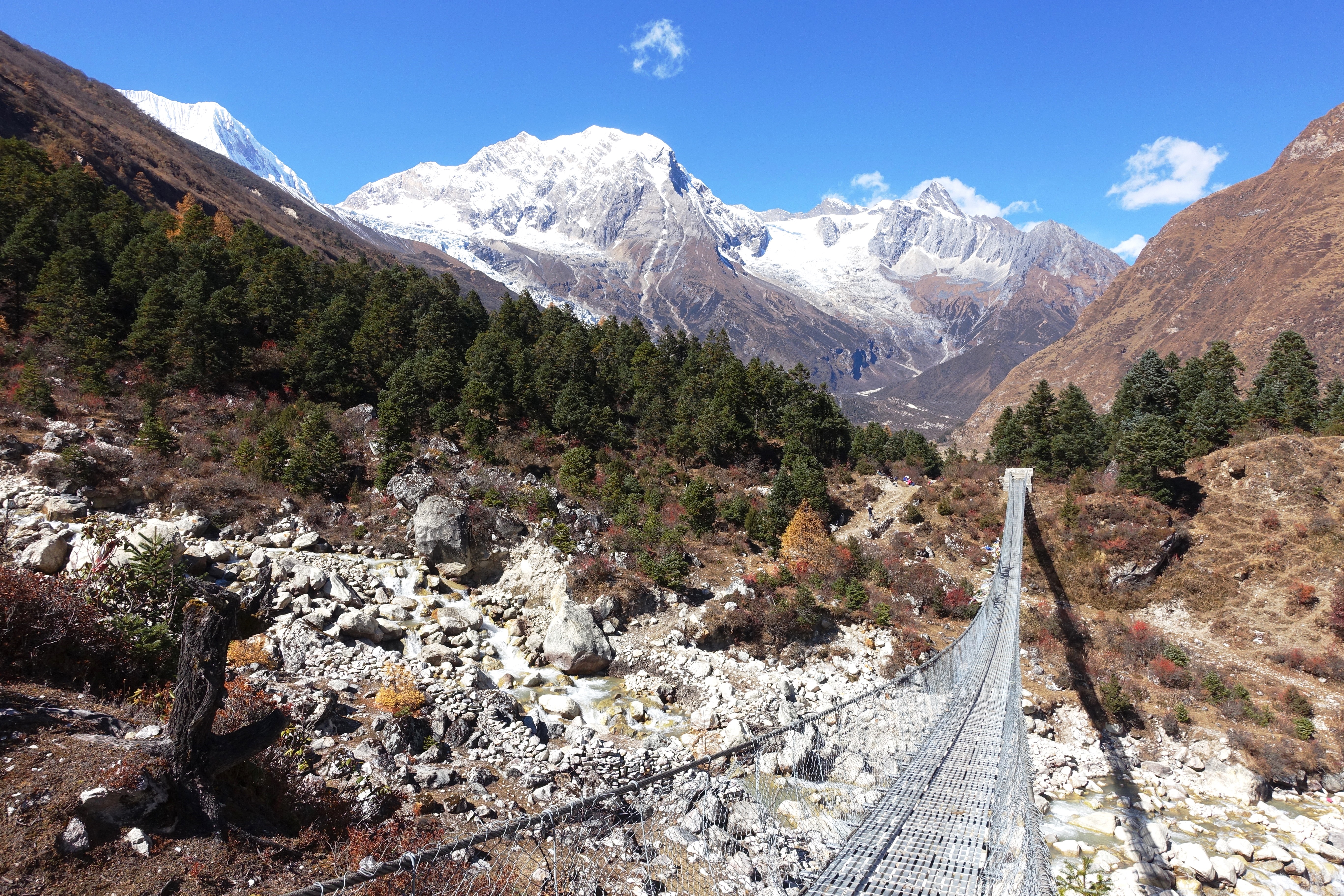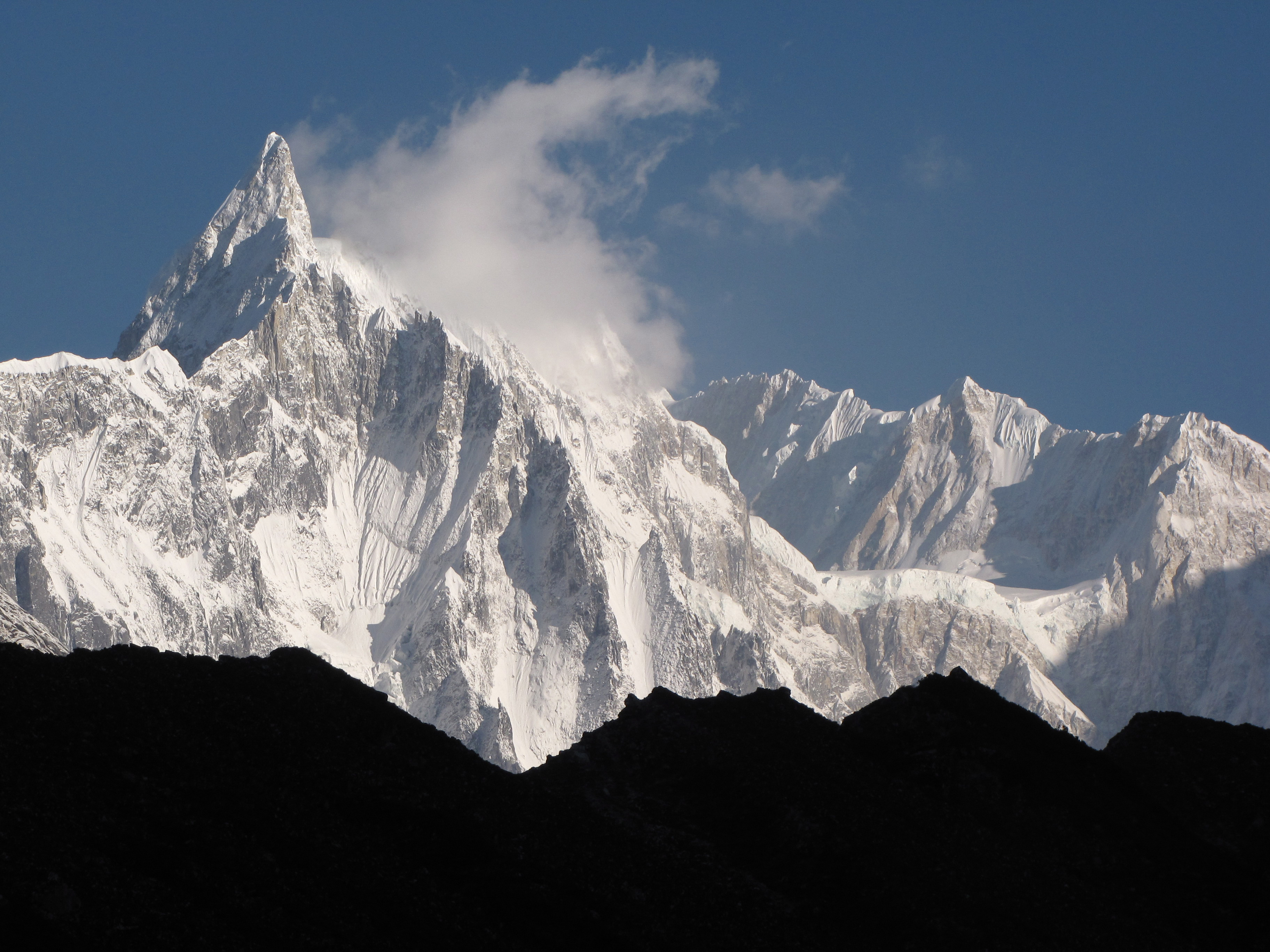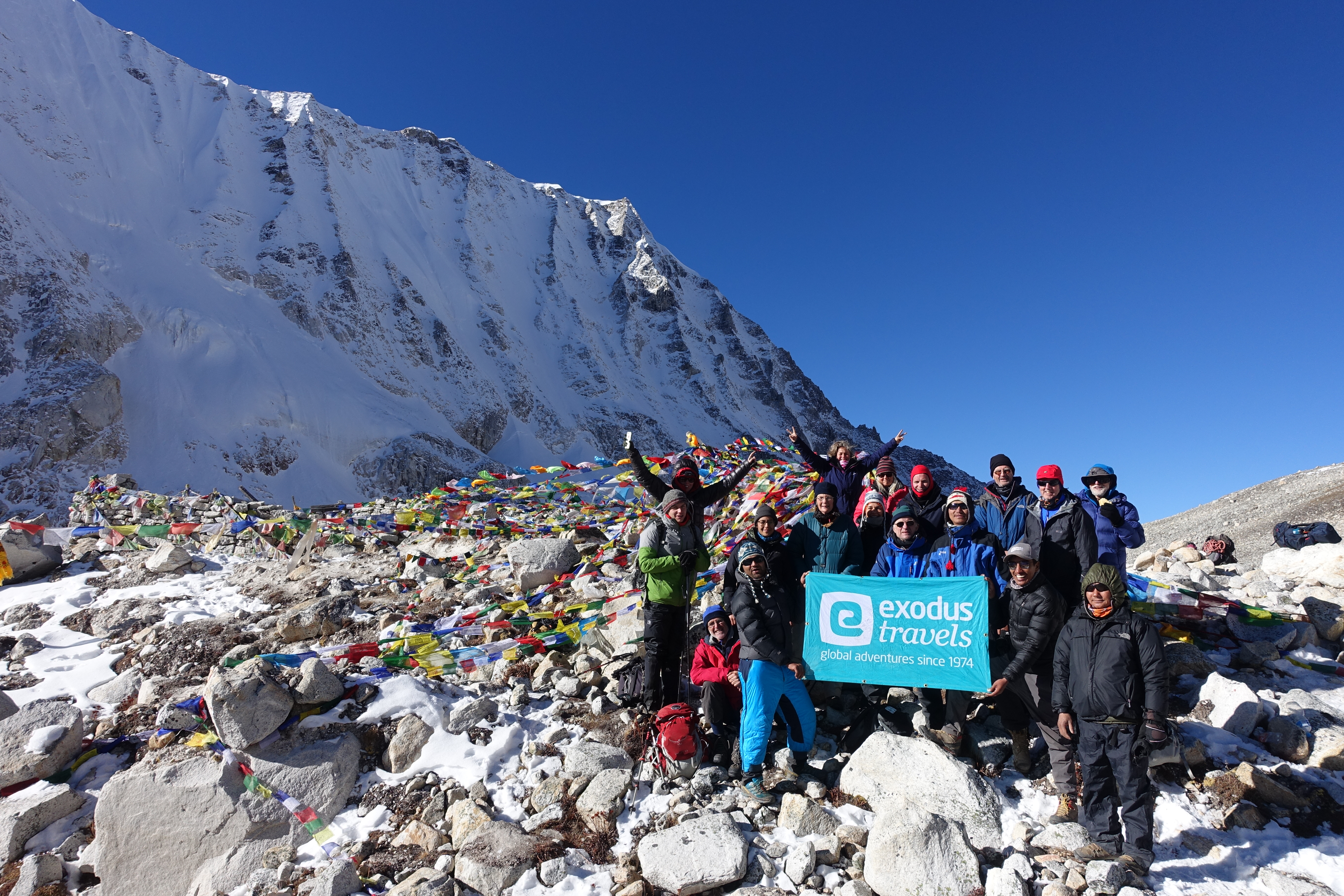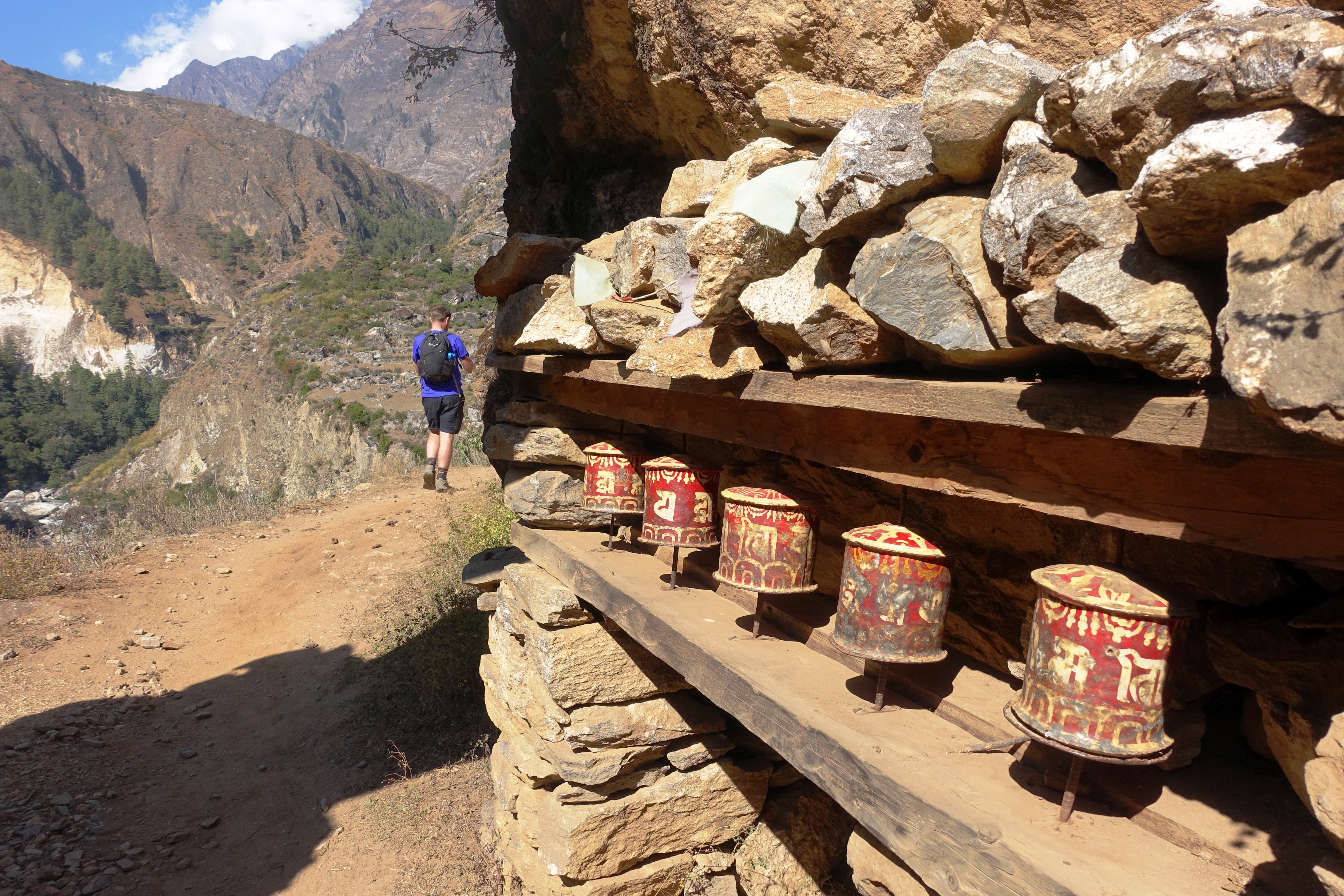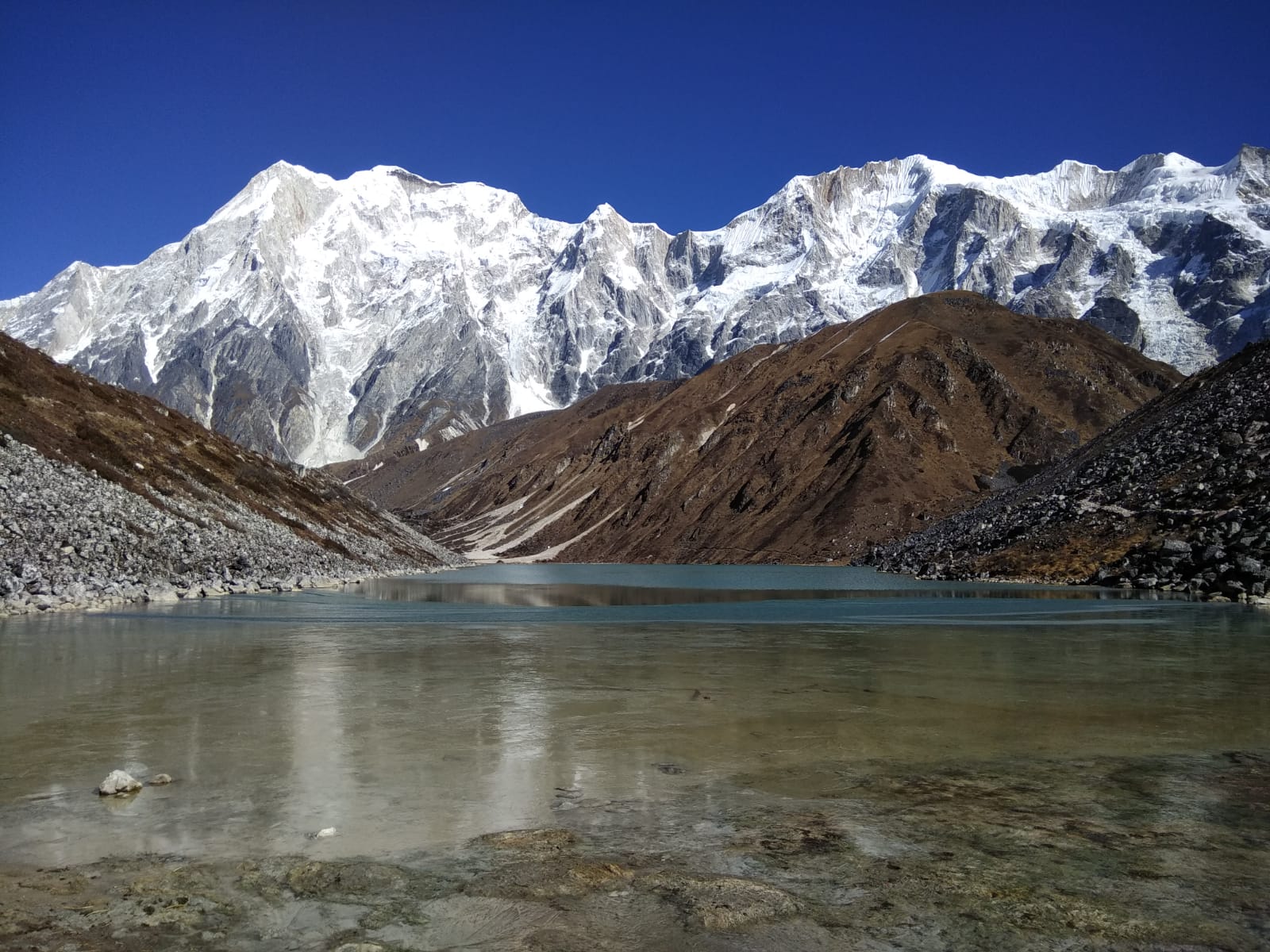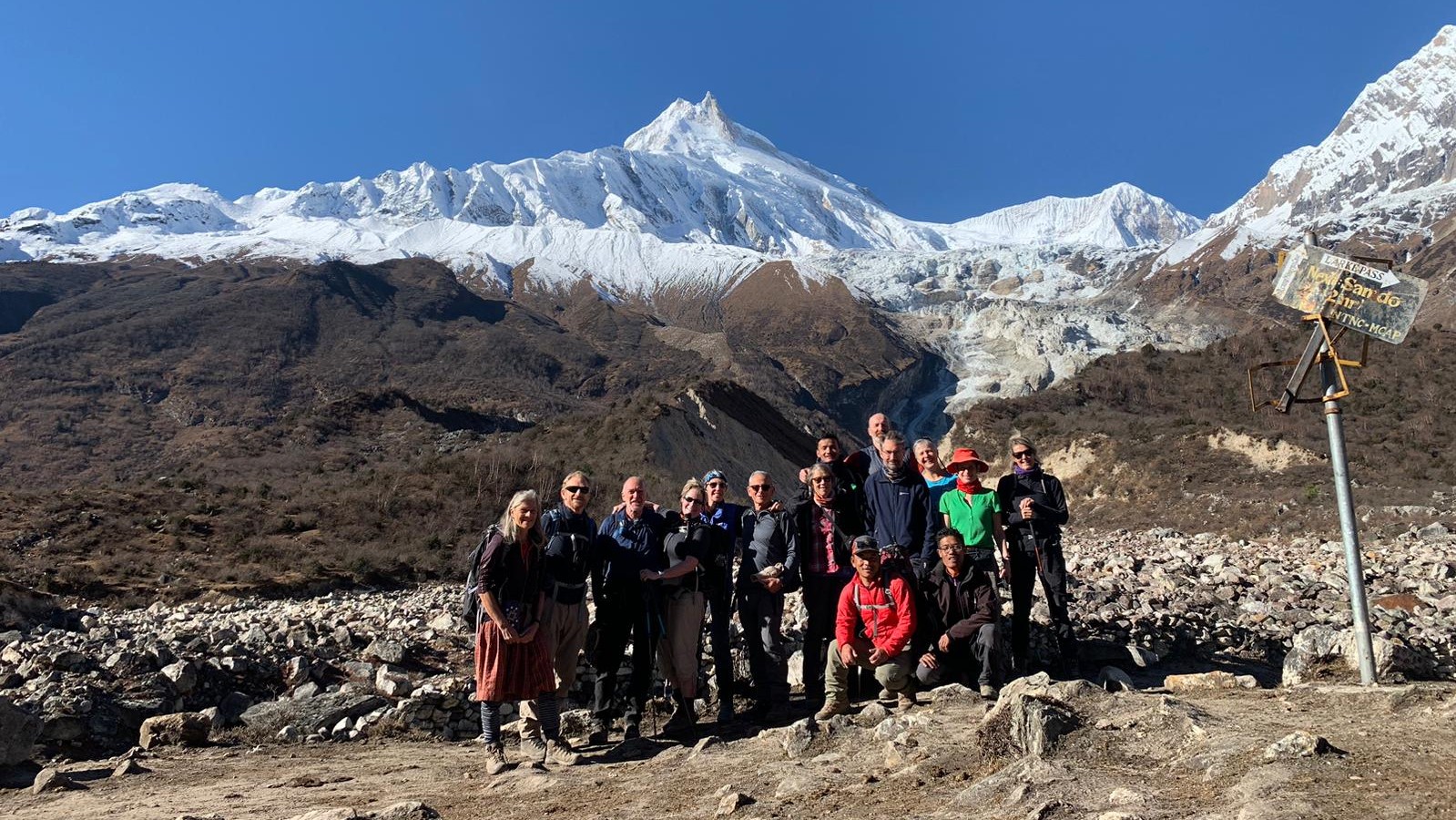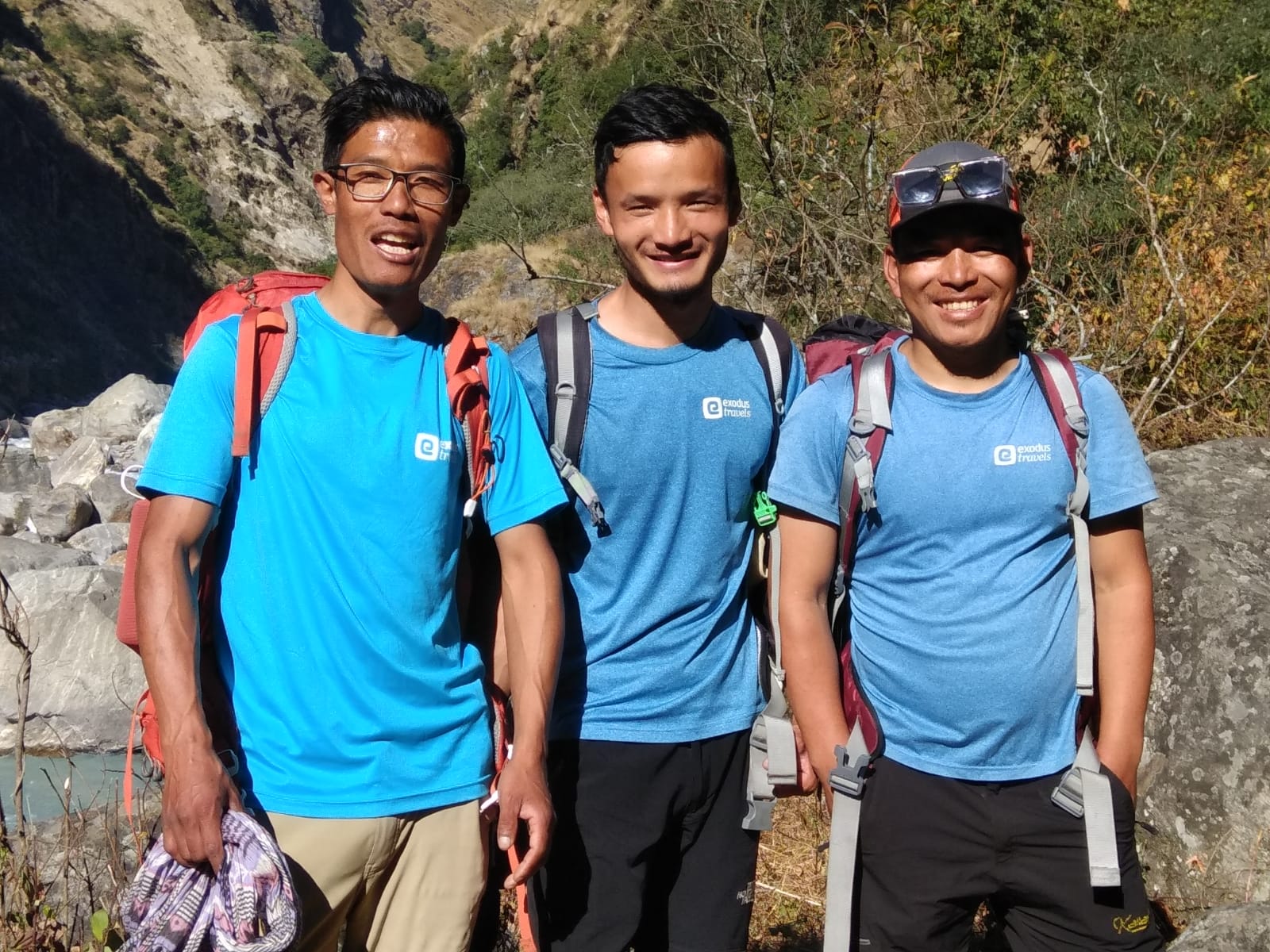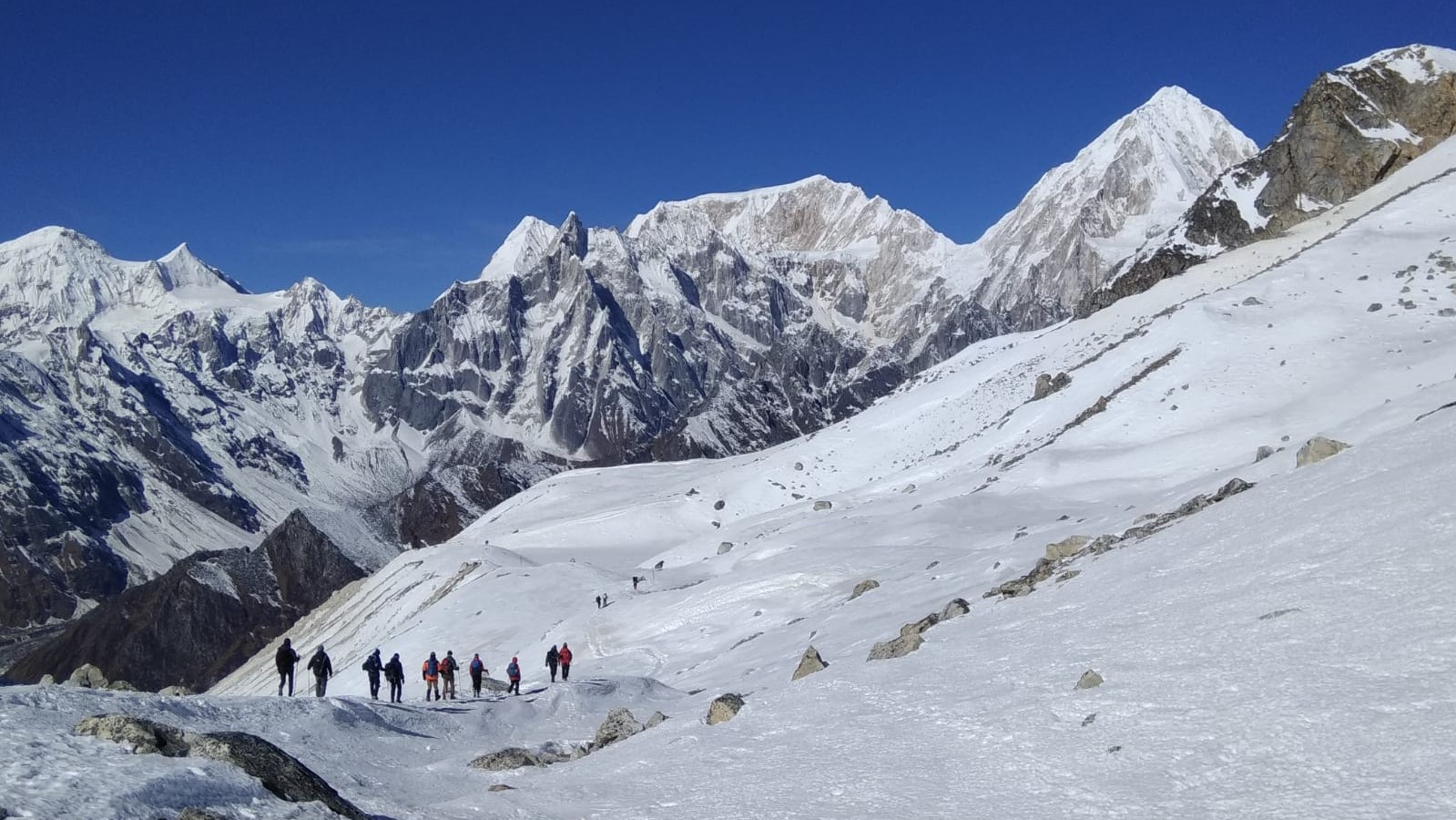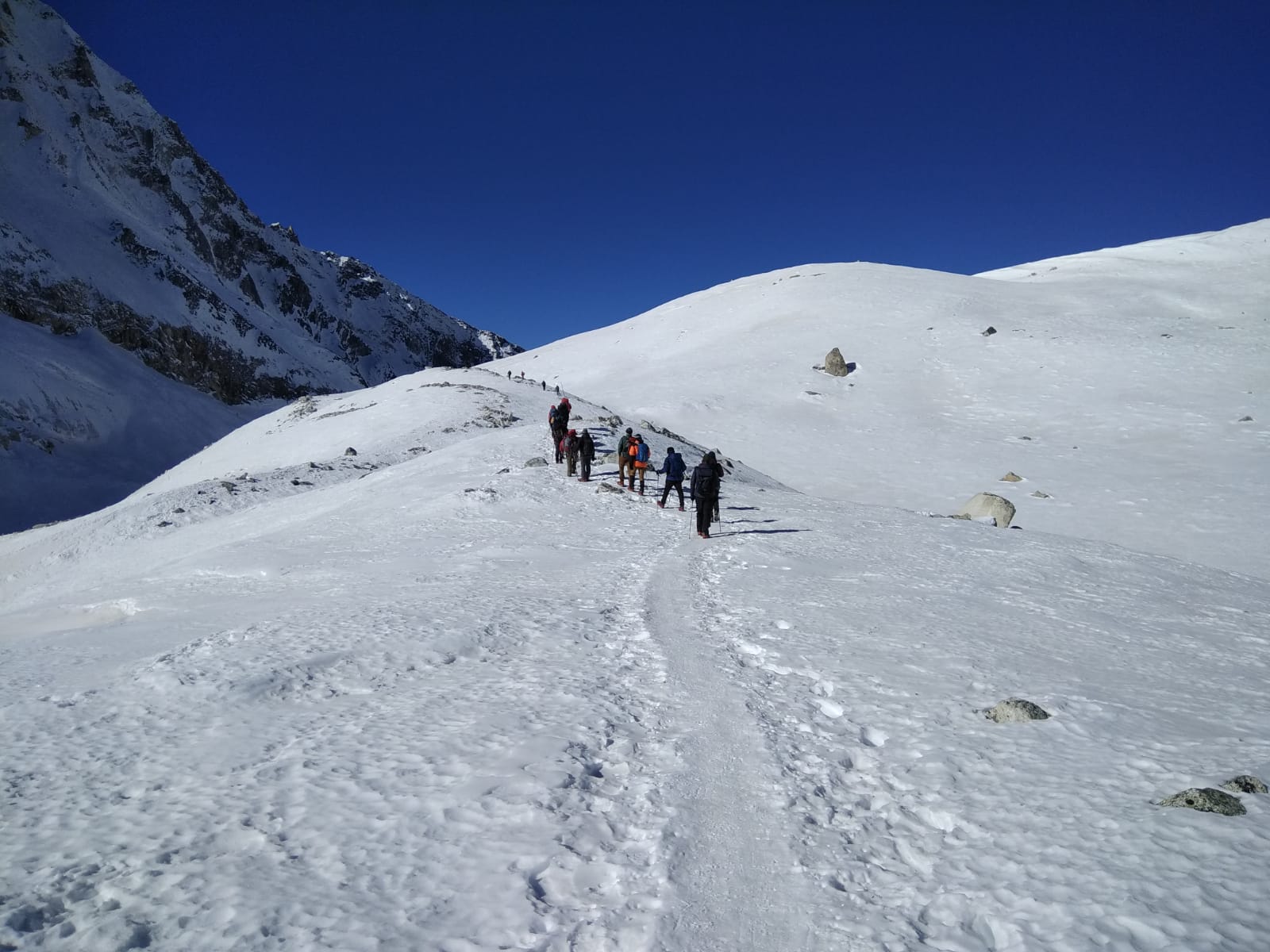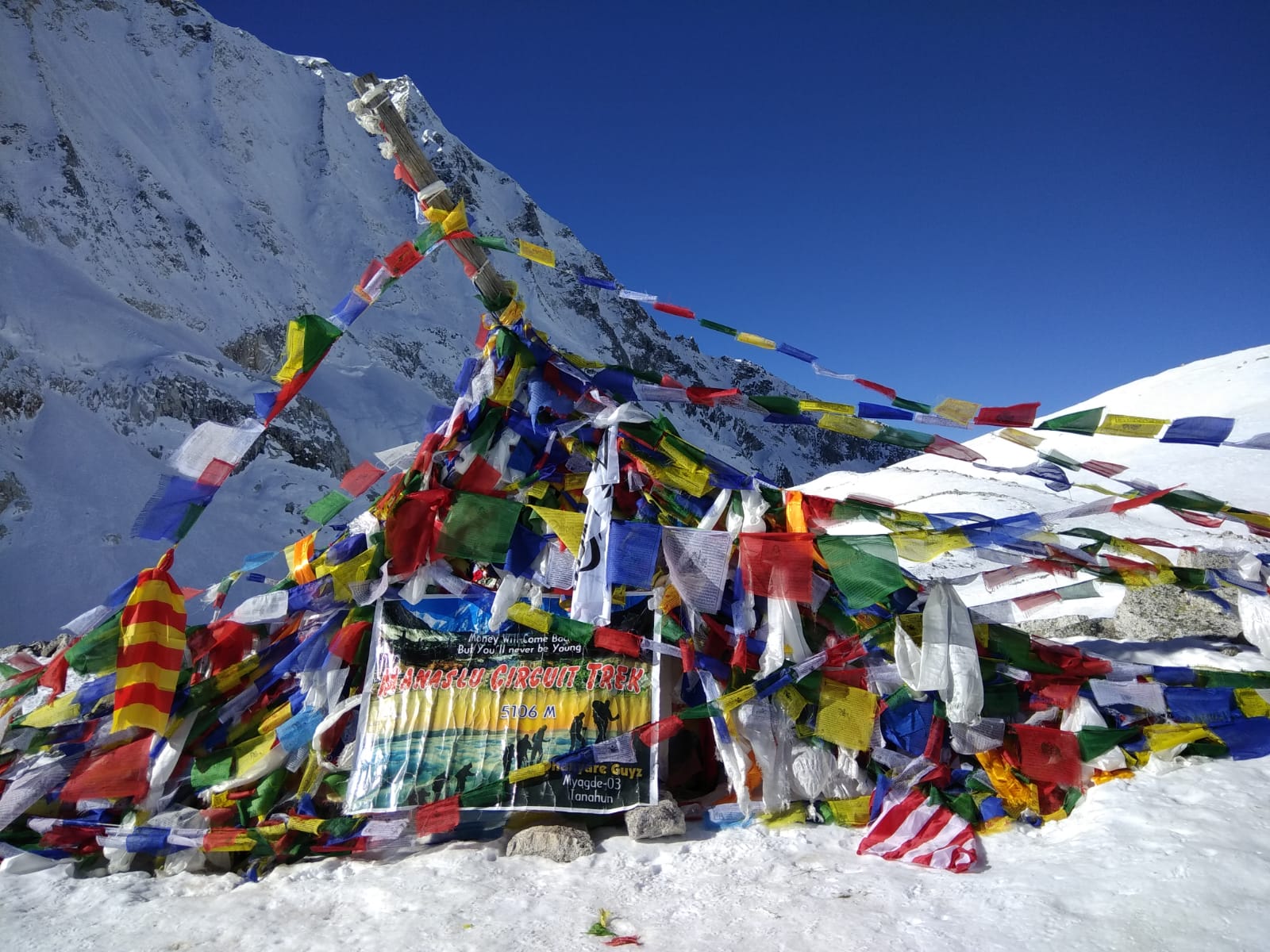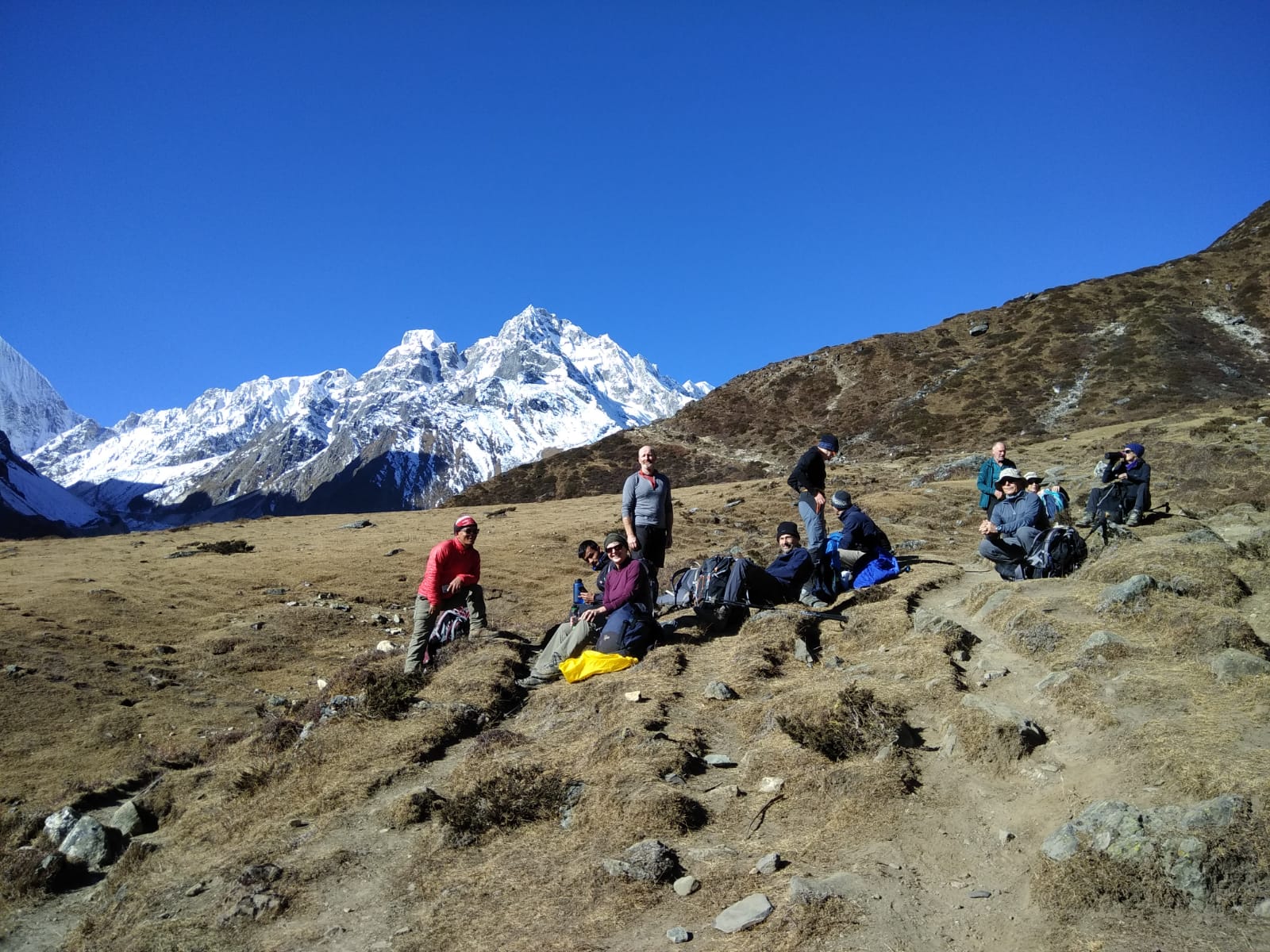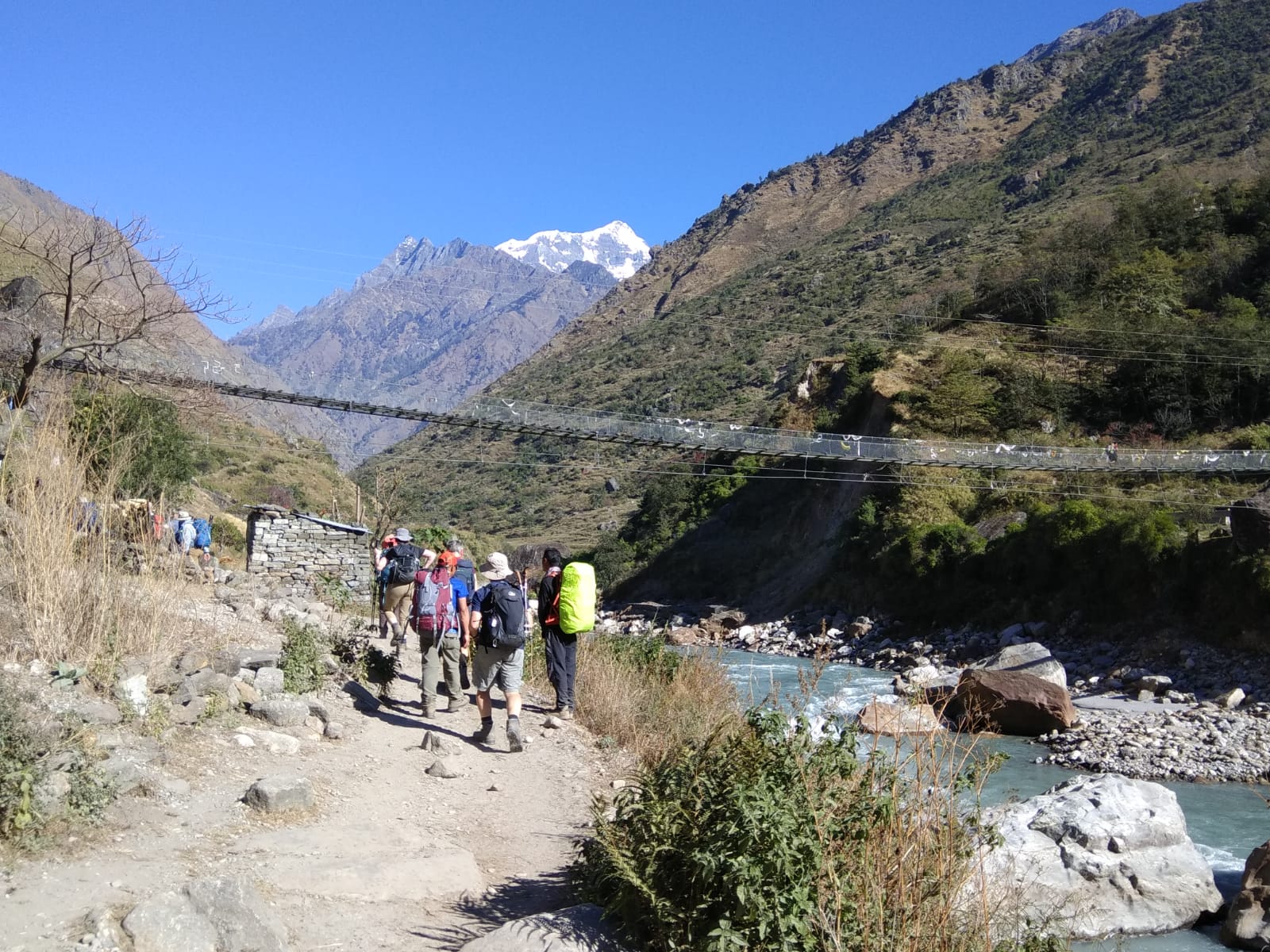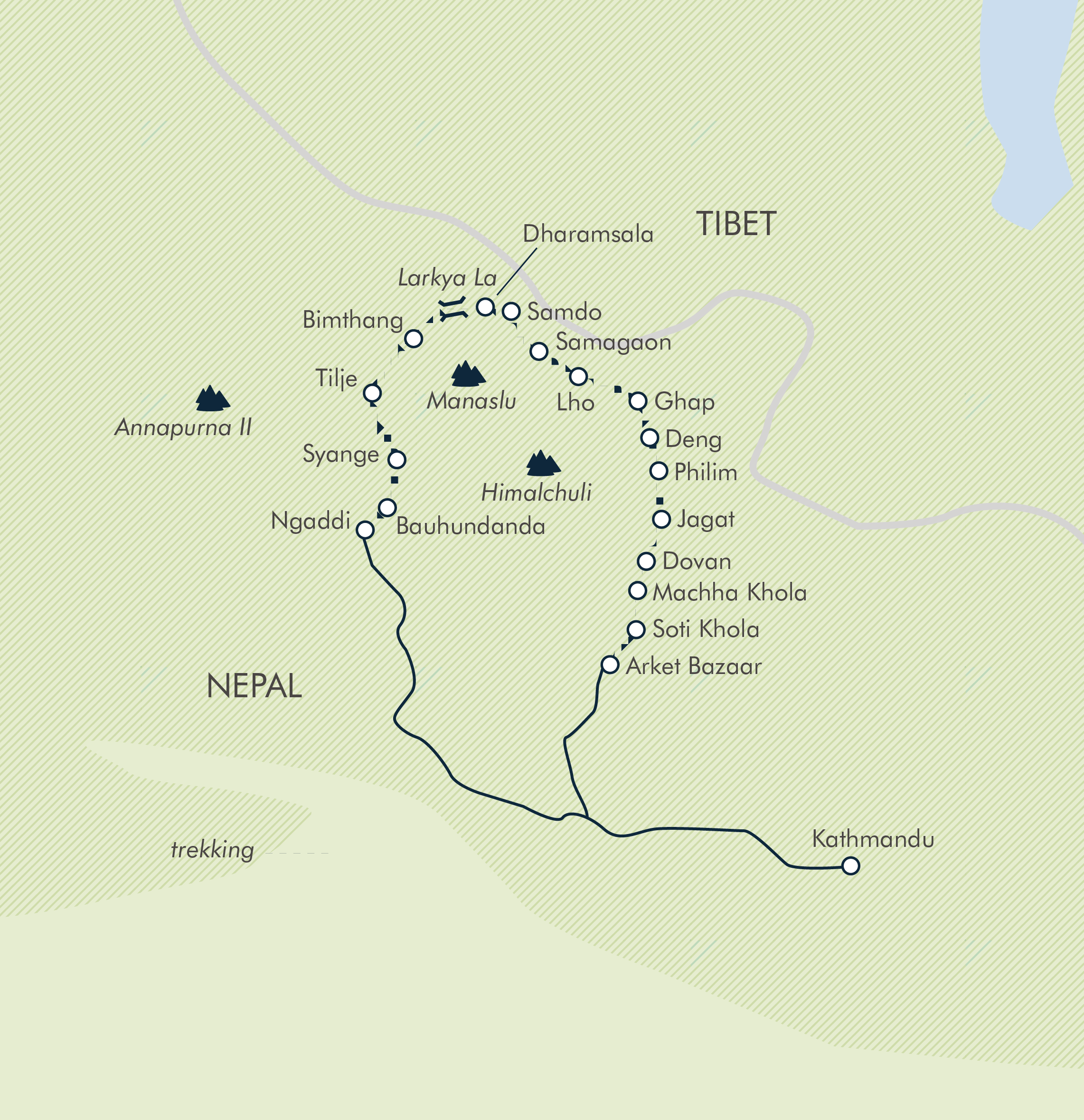Manaslu Lodge Circuit
Manaslu Lodge Circuit
$3375
Manaslu Lodge Circuit
18 Days Starting and ending in Kathmandu
Visiting: Kathmandu, Soti Khola, Machhakhola, Jagat, Deng, Ghap, Lho, Samagaun, Samdo, Dharamsala, Bimthang, Nebu lal shiv mandir, Nache
Tour operator:
Tour code:
TNA
Guide Type:
Fully Guided
Group size:
4 - 16
Age range:
16-99
Special diets catered:
Please inform Exodus of specific dietary requirements
Tour operated in:
EnglishTour Overview
This spectacular and isolated circular trek skirts around the eighth highest mountain in the world, formidable Manaslu (28,258ft/8,163m). We follow the mighty Buri Gandaki River as it narrows into a spectacular gorge, passing through tiny villages perched on valley sides. Eventually, the gorge opens out into alpine meadows inhabited by a cluster of Tibetan communities below the north face of Manaslu. Crossing the Larkya Pass, we see the snow-capped peaks of Himalchuli, Manaslu, Cheo Himal and Himlung Himal, before descending through forest to join the main Annapurna Circuit route.
Why trek with Exodus?
One of the highest staff-to-traveller ratios on the trek with one staff member to every four travellers
More than 30 years’ experience organising treks in Nepal
Carefully planned ascent rates and itineraries with built-in acclimatisation and contingency days
Experienced English-speaking local leaders who are qualified in first aid and trained to recognise and deal with altitude sickness
All staff (leaders, guides and porters) are fully insured and paid a fair wage
Staff carry oxygen, a first-aid kit, and self-assessment acute mountain sickness cards, used to monitor every traveller at altitude
Speak to Exodus office staff who have done the trek themselves
Highlights
Itinerary
Day 1 : Start Kathmandu
Location: Kathmandu
Accommodation: Hotel
The tour starts at the hotel in Kathmandu. Free arrival transfers are available for any flight, provided you have supplied Exodus with your flight details in advance and have requested a transfer. There are no planned activities today so you may arrive at any time; however, tomorrow is a long drive so it’s better not to arrive too late.
Upon arrival at the hotel, look out for an Exodus noticeboard with details of where and when the welcome/trek briefing is held this evening.
Accommodation: Hotel Royal Singi (or similar)
Day 2 : Drive To Arket Bazaar; Trek To Soti Khola
Location: Soti Khola
Accommodation: Hotel
Meals Included: Breakfast
We have an early start for the long drive to Arket Bazaar (approximately seven hours). We drive out of the Kathmandu Valley and head west following the Trisuli River towards Pokhara. At Dading, we turn off the main road and drive into the hills through Dading Besi and Arughat in the Buri Gandaki Valley. From Arughat, we continue on a rough road to Arkhet Bazaar (be prepared for an adventure). From here, we walk (approximately two hours) to Soti Khola.
Accommodation: Teahouse (sleeping altitude: approximately 2,360ft/720m)
Day 3 : Trek Through Forest And Fields To Lapu Besi And Onto Machha Khola
Location: Machhakhola
Accommodation: Hotel
Meals Included: Breakfast
The first few days of this trek are quite long in terms of hours walked due to the lower altitudes and availability of decent lodges. It can, therefore, be very hot, especially in the spring trekking season. Our route begins by following the Buri Gandaki Valley north. There is a road being blasted out of the hillsides and we try to avoid it where possible. From Soti Khola, we drop to the river and cross to the other side of the valley where the trail climbs steeply for a while through forested areas and small villages and then undulates through farmland and finally drops to cross the river again to lunch at Lapu Besi. From Lapu Besi, we follow the undulating jeep track to Machha Khola
Accommodation: Teahouse (sleeping altitude: 2,870ft/875m)
Day 4 : Follow The Buri Gandaki River To Jagat
Location: Jagat
Accommodation: Hotel
Meals Included: Breakfast
We have another quite long day as the trail undulates throughout, sometimes by the river and sometimes high above the river, passing several small hamlets and farms. The valley narrows and there are spectacular waterfalls. We start with a short climb followed by a descent to Khorla Besi. From here, we follow the wide track to Tatopani (which means hot water). The water from the natural hot springs here is funnelled through a few taps in the centre of the village. We continue up to Dovan and then to Shyauli, where we have lunch. From there, we face more ups and downs (some quite steep sections) until we drop to the river at Yaruphant. The trail levels out for a while and then we cross a suspension bridge, after which the trail undulates to Jagat, a well-kept paved village, where we see the first signs of Tibetan Buddhism.
Accommodation: Teahouse (sleeping altitude: 4,495ft/1,370m)
Day 5 : Ascend Through Small Villages To Philim; Climb To Deng
Location: Deng
Accommodation: Hotel
Meals Included: Breakfast
We have a long day due to the lack of decent lodges. From Jagat, the trail continues up the valley through the villages of Salleri, Sirdabas and Ghate Khola, offering great views of Chamar ahead. We then drop down to the river, cross a long suspension bridge and climb steeply up to lunch at Philim (5,135ft/1,565m). From Philim, the trail undulates spectacularly with impressive waterfalls on either side of the valley. Passing the small settlements of Chisapani and Eklabatti, where we have lunch, we descend a little and cross the river by suspension bridge. The trail splits at the bridge, the right-hand side of the valley leads to the remote Tsum Valley. We cross to the left and continue following the Buri Gandaki, climbing up at first as the trail rounds the valley, which becomes narrower. We cross the river twice more as we undulate up the valley through forest to Phewa, and further on to the small village of Deng.
Accommodation: Teahouse (sleeping altitude: 6,135ft/1,870m)
Day 6 : Cross The River And Ascend Via A Magnificent Valley To Ghap
Location: Ghap
Accommodation: Hotel
Meals Included: Breakfast
A shorter day today. From Deng, we descend to the river and cross by bridge. After the river, our route climbs, steeply in places, up onto a spectacular trail. We pass through small settlements as we ascend the impressive valley. We see mani stones (prayer stones) carved into wayside rocks, a sign we are now in a Buddhist area. We pass through the small settlements of Rana and Bihi Phedi. The trail continues ascending (sometimes steeply) but at one point descends to cross the river. We get to Ghap by lunchtime; in the afternoon, there is an optional walk up the hill behind the lodge for spectacular views across to Prok and of the whole valley.
Accommodation: Teahouse (sleeping altitude: 6,925ft/2,110m)
Day 7 : Continue To Lho, Offering Fantastic Views Of Manaslu
Location: Lho
Accommodation: Hotel
Meals Included: Breakfast
Today is quite a strenuous day with a lot of ascent. The valley widens and there is extensive farmland all around where we may see the occasional lookout platform, built to ward off bears. From Ghap, we cross the river three times and have a long steady climb through the forest (look out for langur monkeys) to Namrung. A short descent followed by another climb brings us to Lihi, where we have a simple lunch. Another descent to the river and climb brings us to Sho, after which we climb further to Lho. We are now passing through Tibetan-style villages and we start to see the magnificent mountains all around. From Lho, we get our first view of the Manaslu and Naike peaks
Accommodation: Teahouse (sleeping altitude: 10,400ft/3,170m)
Day 8 : Climb To Samagaon
Location: Samagaun
Accommodation: Hotel
Meals Included: Breakfast
A short but magnificent walk as we continue up the valley and gain altitude. The trail climbs out of Lho to the monastery, which we can visit. We then follow the valley with great views of Manaslu ahead. The trail climbs for a couple of hours to Shyaula village, from where we are surrounded by amazing views. Manaslu is ahead and we can see Himalchuli and Naike peaks. Soon we reach the fields and stone houses of Samagaon, where we stay for the night. From the lodge, there are magnificent views of Manaslu. We should arrive at Samagaon by lunchtime so there is time to explore the village and visit the monastery and Birendra Tal, a glacial lake, in the afternoon.
Accommodation: Teahouse (sleeping altitude: 11,580ft/3,530m)
Day 9 : Trek To Samdo
Location: Samdo
Accommodation: Hotel
Meals Included: Breakfast
The trail crosses grazing areas and gradually climbs the valley. We have fantastic views of the mountains, especially Himalchuli, behind us. We can also still see Manaslu. As we reach our destination, Samdo Peak rears up behind us. It’s an easy half-day walk to Samdo, the last permanent settlement in the valley. This remote village is only a day’s walk from the Tibetan border. In the afternoon, there is time for an acclimatisation walk and to explore the village. Please note, the lodges in Samdo are basic.
Accommodation: Teahouse (sleeping altitude: 12,665ft/3,860m)
Day 10 : Ascend To Dharamsala
Location: Dharamsala
Accommodation: Hotel
Meals Included: Breakfast
Leaving the village, we cross a stream (the last time we see the Buri Gandaki) and climb steadily to the deserted Larkya Bazaar. Years ago, this village thrived off trade with Tibet. Behind we can see Samdo Peak and, as we climb, Manaslu comes into view to our left and we can see the whole spectacular climbing route to the summit. Climbing all the time with a few steep sections, we reach a very basic lodge at Dharamsala, which is the last place to stay before the pass. Look out for blue sheep, which often come down to the small stream near the lodge. In the afternoon, the energetic can climb a hill behind the lodge for even better views of the surrounding mountains.
Please note, the accommodation at Dharamsala is extremely basic due to limited properties in this location. There are three-person prefab huts or, where available, tents are provided for those that do not wish to triple-share. Mattresses are provided in the huts and there is a basic dining room and basic toilets.
Accommodation: Three-person huts (sleeping altitude: 14,700ft/4,480m)
Day 11 : Cross The Larkya La; Descend To Bimthang
Location: Bimthang
Accommodation: Hotel
Meals Included: Breakfast
We have an early start (usually in the dark). Today is a long day and if there is any snow it can take us a long time to cross the pass, especially the descent. The trail leaves Dharamsala and climbs steeply at first but then more gradually by the side of the moraine of the glacier with great views of Larkya Peak. The ascent is gradual most of the way and is easy if there is no snow (if there is snow or ice it takes much longer). As dawn nears, Hindu Peak glows orange with the first sun rays. It’s a long and rocky ascent on the moraine with some short steeper sections all the way to the top of the Larkya Pass. The first area of prayer flags at 16,830ft (5,130m) is the official Larkya La from where the views are outstanding – a wonderful panorama of peaks including Larkya Peak, Cheo Himal and Hindu Peak and, in the distance, we can see the tip of Annapurna 2. From the top, there is a 10-minute almost-level walk to the second summit (which is a little higher and is also marked with a few prayer flags). From here, the long, very steep descent starts. We need to take care as the path is steep and narrow. It is a sandy scree trail when there is no snow but if there is snow and ice, we need to take care. There is a landslide we must cross carefully. The steep part of the trail eventually eases off onto a path, which takes us down to the glacial moraine. The views are superb as we descend, and we can just spot Pongkar Lake, a brilliant-blue glacial lake amid the three glaciers below us. We stop for a well-deserved rest at the bottom of the steep part of the descent, surrounded by immense snow-capped peaks. The descent now becomes a bit easier, but no less spectacular, as we descend the valley to Bimthang, where we stay tonight. If it’s clear, we can just see the summit of Manaslu high above.
Accommodation: Teahouse (sleeping altitude: 12,140ft/3,700m)
Day 12 : Daywalk To Pongkar Lake Or Spare Day As Required
Location: Bimthang
Accommodation: Hotel
Meals Included: Breakfast
A spare day to be used as and when required – if the weather is good and everything runs to schedule, we spend the day exploring the area around Bimthang and resting after the pass. There is a half-day walk to a beautiful glacial lake, Pongkar Lake, which we can do in the morning, then return to the lodge for lunch and have a free afternoon to rest.
If, however, there has been a delay earlier in the trek, the group needs more acclimatisation or rest before the pass, or if there is poor weather, your leader may decide to use the spare day earlier in the trek. Also, if the weather is bad at Bimthang, your leader may suggest trekking down the valley earlier. This is at the leader’s discretion.
Accommodation: Teahouse (sleeping altitude: 12,140ft/3,700m)
Day 13 : Spectacular Walk To Tilje
Location: Nebu lal shiv mandir
Accommodation: Hotel
Meals Included: Breakfast
From Bimthang, we cross high pastureland and have a magnificent walk down into the valley of the Burdin Khola. The walk from Bimthang is one of the most spectacular of the trek as a wall of mountains lies behind and in front. We pass the terminal moraine of the Cheo Himal and cross a small wooden bridge. Ahead, we have our last magnificent views of Manaslu. We now descend into rhododendron forest and follow a trail through a narrow valley to Karche and the Soti Khola. A short climb past terraced fields brings us to the Karche La, where we are in sight of the Marsyangdi River below. Descending through forest, we come to Tilje, where we spend the night.
Accommodation: Teahouse (sleeping altitude: 7,350ft/2,240m)
Day 14 : Trek To The Remote Nache; Descend To The Main Annapurna Circuit Trail
Location: Nache
Accommodation: Hotel
Meals Included: Breakfast
From Tilje, we walk through the village and cross the river by bridge. A small footpath then leads away from the main trail and we follow this uphill through the forest. A higher path takes us to a small monastery among pine forests. We get great views of Dharapani below and Annapurna 2 above. We then descend past terraces to a suspension bridge, which we cross. The trail then climbs up to Nache village. This old village rarely sees trekkers and has beautiful traditional Gurung houses. We can also see Manaslu and Himalchuli. We then descend quite steeply to the main Annapurna trail at Korto. Staying on the same side of the river, we follow the old trail, which climbs high above the river and undulates until we descend to Tal for the night.
Accommodation: Teahouse (sleeping altitude: 5,580ft/1,700m)
Day 15 : Descend To Syange Via Chyamje And Jagat
Location: Jagat
Accommodation: Hotel
Meals Included: Breakfast
A short climb out of Tal brings us to a long descent to cross the Marsyangdi by bridge, followed by a short climb to Chyamje. From Chyamje to Jagat, we can climb above the road and follow the old trekking trail through the forest to Jagat. From Jagat to Syange, we have to walk on the jeep track for a short while for our last night of the trek.
Accommodation: Teahouse (sleeping altitude: 3,545ft/1,080m)
Day 16 : Drive To Besishar; Transfer To Kathmandu
Location: Kathmandu
Accommodation: Hotel
Meals Included: Breakfast
Leaving early, we take a local private bus to Besishar on a rough road for approximately 2hr 30min. From here, we meet our next transfer for the long drive to Kathmandu (approximately five to six hours). We should arrive at our hotel in the late afternoon.
Accommodation: Hotel Royal Singi (or similar)
Day 17 : Free Day In Kathmandu
Location: Kathmandu
Accommodation: Hotel
Meals Included: Breakfast
Today is free for sightseeing in Kathmandu. You may wish to visit the monkey temple at Swayambunath, one of the largest Buddhist stupas in the world at Boudhanath, or the most important Hindu temple in the valley at Pashupatinath. We offer a full range of sightseeing tours, which can be booked and paid for locally. Please see the Optional Excursions section of the Trip Notes or the Exodus notice board in the hotel in Kathmandu.
Accommodation: Hotel Royal Singi (or similar)
Day 18 : End Kathmandu
Location: Kathmandu
Meals Included: Breakfast
The trip ends after breakfast. Free departure transfers are available for any flight, provided you have supplied us with your flight details in advance and have requested a transfer.
What's Included
-
All breakfasts included
-
Morning bed-tea on trek
-
Welcome drink at each overnight lodge
-
Three nights in standard hotels, 13 nights in teahouses and one night fixed tent
-
All transport and listed activities
-
Tour leader throughout, plus local staff (staff to client ratio of 1:4 on trek)
-
Free arrival and departure transfers for everyone
-
Full porterage throughout trek
-
Exodus kitbag
-
Trekking permit and national park fees
What's Not Included
-
Travel insurance
-
Single accommodation (available on request, Kathmandu only)
-
Visas or vaccinations
-
Sleeping bag (possible hire in advance through Exodus)
-
Down jacket (possible hire in advance through Exodus)
Food
Breakfast is included throughout the trip.
In teahouses, breakfast comprises a choice of bread (a slice of toast, chapatti or Tibetan bread), a choice of egg (boiled, fried or omelette), and a choice between either muesli or porridge each day. Hot tea/coffee is also served. On specific days, there will not be a choice for breakfast and either a trekkers breakfast (egg, hash brown, baked beans and toast) or a pancake with jam/honey is served – these options are not available in all teahouses and so we have only included them in locations where they can be guaranteed. You may also be able to supplement your included breakfast with additional items on the teahouse menu should you wish, additional items that are not included in the set menu should be ordered and paid for separately.
Please note, some more remote teahouses/lodges are unable to provide an extensive menu due to irregular delivery schedules and during periods of bad weather or a high volume of trekkers, there may be a more limited menu choice. Also, the higher altitude the more expenses the menus and extras generally are.
Lunch is at a teahouse en route – sometimes one of your guides will go ahead with the group’s order to make it more expedient. Dinner is in the same teahouse you sleep at (this is custom in Nepal as teahouses base their room rate on it).
Although most lodges have almost identical menus, they are reasonably extensive and offer a varied selection, ranging from traditional Nepalese dhal bhat to pizza and apple pie. Dhal bhat is the staple diet in Nepal and comes in many different forms but generally comprises some curried lentils and meat or vegetables, some rice, and a pickle/chutney. Another popular snack is momos, a Nepalese dumpling, fried or steamed and filled with meat or vegetables.
Meat is available in the teahouses but we advise against eating it on trek. The meat has often been carried in the heat from lower altitudes for several days before reaching the lodges and can cause stomach upsets or illness.
If you have a gluten-free diet, we strongly recommend you bring extra food and snacks with you to supplement the food on trek as there will be little variety available for you, particularly for breakfast. Even many of the soups are powdered and contain gluten. Gluten-free breakfast options will be limited to vegetable fried rice and a choice of egg, and on specific days only, a trekkers breakfast (without the toast/with an extra egg) will be served. Breakfast options for vegans will be limited to a choice of muesli/porridge with water each day, and on specific days only, a trekkers breakfast (without the egg), or vegetable fried rice will be served. If you are lactose intolerant, the same will apply although you will also have a choice of egg each day.
If you buy imported food and drink on trek, you will spend more than the suggested amount.
Drinking water
Staying hydrated is important when undertaking any physical activity but particularly so at altitude where it is generally recommended to drink at least 100floz-135floz (3-4 litres) per day.
However, we strongly encourage you not to buy bottled water on trek as this contributes to the growing problem of plastic pollution in Nepal.
The teahouses sell boiled water for approximately 150-300 (US$1.15-US$2.30) per litre (the price increases the higher you trek) which should not require treating. This is also perfect for a bedtime refill as it can double up as a hot-water bottle.
Alternatively, all teahouses provide free cold water. Although this should not be drunk untreated, we recommend you bring a reusable bottle/water bladder/Camelpak (ideally two) and use an effective form of water treatment. There are a wide range of products available including Steripens or purification tablets, which are the quickest and easiest options to use on trek – we recommend talking to an outdoor retailer for the latest advice as technologies are improving all the time. Make sure to check the product’s performance in cold/freezing conditions and consider battery life (lithium batteries are best in cold conditions).
Exodus has partnered with Water-to-Go, a filtration system that eliminates more than 99.99 percent of all microbiological contaminants from any non-saltwater source – visit Water-to-Go for more information. Exodus customers can claim 15 percent off their first order and, better still, 15 percent of the purchase value will be donated to the Exodus Travels Foundation. These bottles filter the water as you drink through the spout may not be the most efficient while on the go on a trek. Please note, if the water freezes it will clog up the filter. In this event, defrost before use by sitting the filter in lukewarm water for 10-15 minutes.
Accommodation
Spend 13 nights on trek in teahouses/lodges, one night in Dharamsala in three-person prefab huts, and three nights in a hotel in Kathmandu.
In Kathmandu, we usually stay at the Hotel Royal Singi, located within walking distance of the buzzy Thamel district. There is a restaurant, bar and an outdoor courtyard, plus free wifi in the lobby and login codes for the rooms are available at reception. There is an Exodus desk in the hotel reception area and an Exodus representative is usually available daily in the mornings and evenings.
The teahouses are basic (especially the ones in Samdo and Dharamsala) but adequate; please be realistic about what to expect in the mountains. In Dharamsala, we use three-person prefab huts. Mattresses are provided in the huts and there is a basic dining room and basic toilets.
The hub of the teahouse is the dining room, usually decorated with colourful traditional rugs, sometimes with a stove or heater (some lodges charge a fee to put the heater on). Some tea houses above 9,845ft (3,000m) may not be heated due to local environmental restrictions. Occasionally, kerosene burners can be used to heat common areas if requested. We recommend against using these due to the risk of carbon monoxide poisoning, and your leader will not offer this to you. Most teahouses sell snacks and other essentials such as tissues, soap and toilet paper. Almost all lodges have electricity, but it is not wholly reliable, and lighting may not be bright enough to read by – a torch (flashlight) is essential. Electrical charging facilities are generally available only in the dining room, charged at approximately 150-350 Nepalese rupees (US$1.15/US$2.65) per hour per device. Many of the lodges use solar power so sometimes there is not enough electricity for charging. A few of the lodges on this trek have wifi – in some areas it works well but in others it is slow and temperamental.
The bedrooms are now almost all twin-share (although very occasionally during peak seasons you may be asked to share with three to a room for the odd night). Beds with foam mattresses, bedsheets and a pillow are provided. Bedrooms are unheated and can get cold at night, so you need to bring or hire a sleeping bag.
Most lodges have only one or two basic toilets and sometimes these are outside the main lodge building. Toilets are usually Asian squat style; although some lodges have now installed seated ones. Toilet paper is not provided, so bring your own or buy it locally (please dispose of it in the waste can provided – do not put it in the bowl). If there is not a flush handle, there should be a container of water to pour down – if it is empty (or frozen) please either refill it or ask the lodge to.
Some lodges now have hot showers, charged at approximately 250-500 rupees (US$1.90- US$3.80) per shower. Sometimes a hot shower is simply a bucket of hot water and not a shower head.
Standards of cleanliness vary, especially in the peak trekking season and in winter when the water freezes at night. Please report any problems to your leader or the lodge and be vigilant in your personal hygiene regime – use soap or hand-sanitiser gel before and after toilet breaks, snacks, mealtimes and after handling money. As a rule, the higher you go, the more basic the lodges and the more expensive food and services become.
Extra accommodation
If you would like to extend your stay, speak to your sales representative about booking extra nights before or after the tour in Kathmandu – please enquire at the time of booking.
Single supplements
If you prefer your own room, we offer a single supplement for the hotel nights in Kathmandu and Pokhara only (subject to availability). While in the tea houses, single rooms cannot be guaranteed so these have not been included in the single supplement price paid in advance. However, if a single room is available on arrival to a teahouse, you can pay locally on a day-by-day basis.
Check out our Q&As
-
Who is Exodus Travels?
At Exodus Travels, we've been exploring the world for nearly 50 years. From Walking and Trekking, Cultural and Cycling, Responsible Wildlife, to Polar and our new Premium Adventures, we are proud to offer award-winning small group and self-guided tours to 100+ countries worldwide.
-
Are flights included in this tour?
International flights are not included with this tour.
-
Are children permitted to take part in the tour?
The minimum age for this tour is 16 years old.
-
Can you assist with pre or post tour accommodation?
We are happy to assist with pre and post tour accommodation. Please enquire for detailed information.
-
Are the local guides on the tour English speaking?
Yes, our local guides are English speaking.
-
Is there a supplement for solo travellers?
If you would like to be paired with a tour member of the same gender, there is no additional charge. A single supplement can be requested if you would like your own room.
-
What happens if I need to change my holiday date once I’ve booked?
If you wish to make any changes to your booking, particularly if you need to alter any flights booked through us, please let us know as soon as possible. There is a booking or flight amendment fee of £40 per change and flight amendments often incur extra airline costs depending on the changes to be made and if the ticket has been issued or not.
-
How long has the tour company been trading?
Exodus has been trading since 1974
-
What documents will I receive before I travel?
Your final joining instructions and flight details, if booked with us, will then be sent out 2 to 3 weeks before departure. If you would like a hard copy posted, or if you require these any earlier, please contact the customer operations team. We advise that if you are booking connecting travel before receiving these, please ensure you leave plenty of time.
-
Do you operate a “single share” option and how does it work?
Travellers are welcome to opt to share a room with a tour member of the same gender for no additional charge. If you'd like your own room, we can request a single supplement so that you will have your own room throughout.
-
Can I join the tour once it has departed?
You are welcome to meet the group after the tour has departed however there is no reduction in rate for joining a tour after the departure date.
Reviews from travellers on this tour
1 Select your preferred date
Thursday - Sunday
Mar 27, 2025 - Apr 13, 2025Thursday - Sunday
Apr 17, 2025 - May 04, 2025Thursday - Sunday
Oct 09, 2025 - Oct 26, 2025Thursday - Sunday
Oct 16, 2025 - Nov 02, 2025Thursday - Sunday
Nov 06, 2025 - Nov 23, 2025Thursday - Sunday
Nov 13, 2025 - Nov 30, 2025Thursday - Sunday
Nov 20, 2025 - Dec 07, 2025Thursday - Sunday
Dec 04, 2025 - Dec 21, 2025Thursday - Sunday
Mar 05, 2026 - Mar 22, 2026Thursday - Sunday
Mar 19, 2026 - Apr 05, 2026Thursday - Sunday
Mar 26, 2026 - Apr 12, 2026Thursday - Sunday
Apr 09, 2026 - Apr 26, 2026Thursday - Sunday
Apr 16, 2026 - May 03, 2026Thursday - Sunday
Oct 08, 2026 - Oct 25, 2026Thursday - Sunday
Oct 15, 2026 - Nov 01, 2026Thursday - Sunday
Oct 22, 2026 - Nov 08, 2026Thursday - Sunday
Nov 05, 2026 - Nov 22, 2026Thursday - Sunday
Nov 12, 2026 - Nov 29, 2026Thursday - Sunday
Nov 19, 2026 - Dec 06, 2026Thursday - Sunday
Dec 03, 2026 - Dec 20, 2026Book with Confidence
-
Transfer as credit to Future Tours
Exodus Adventure Travels allows you to transfer existing payments to a future tour to avoid cancellation fees if you can't travel and inform exodus adventure travels, 43 days before departure.
-
Low Deposit
Exodus Adventure Travels requires a minimum deposit of 25% or the full booking value, whichever is less, with the final balance not due until 90 days before departure.
-
Cancellation Policy
We don't charge a cancellation fee, here is a summary of exodus adventure travels charges.
Up to 70 days before tour starts: Forfeit 100% of deposit.
